Usually when someone makes reference to the “two nations divided by a common language” they mean the UK and US. They could, however, just as easily substitute NZ.
Dunedin is simultaneously familiar and yet strangely foreign. A significant proportion of streets, districts, parks, shops, etc are named after places in Edinburgh, which is, after all, the very city’s namesake (the Burgh of Edin vs. the Dun of Edin). They still even drive on the left here (albeit with metric distances and speeds and a really crazy “give way to drivers turning against you” rule). But they’ve evolved their own crazy version of English, where, for example, TV ads bemoan the fact that you can buy cigarettes in the dairy, you wheel a trundler round the supermarket, you can win a trip to a bach of your dreams anywhere in the world, shops have large “EFTPOS” signs in their windows, and radio programmes can talk for an hour about students getting their “OE” in London or New York without ever once explaining what that actually is.
They also have their own version of the Australian habit of shortening everything to two syllables: it took me much too long to realise that “Coro Street” wasn’t just a local soap (and, as an aside, the UK population should pray that no-one at the BBC decides to fill that newly created Neighbours gap with Shortland Street…)
And that’s all before you deal with the Maori influence (and have to learn how to pronounce place names like Whangarei and Ngongotaha), and the variety of words that have leaked through into everyday language.
I’m also reliably informed that calling yourself “George Street Normal School” is perfectly acceptable in many countries, but to me it sounds like someone trying to find an even more innocuous sounding way of saying “Special School”.
And it’s not just the language. I’ve also never quite worked out why you get your Fish And Chips from a Chinese Takeaway, or why soft drinks come in 600ml containers, and it’s taken me a while to get used to my toaster being inside a cupboard. And you can always tell you’re in a small country when primetime TV has ads for fork lift trucks. (I really want to provide a link so that everyone can enjoy the ludicrous jingle of “There is nothing like a Crown / For picking it up / And putting it down” but I can’t find it anywhere. Help, please, anyone!)
But there are some things that are fantastic here. A small example is that they have a TV listings magazine for intelligent people, that actually thinks nothing of running a 5 page article on an interesting topic. It’s not quite the New Yorker, but it’s certainly no Heat.
A common pet peeve of mine is also neatly avoided here in that they have at least as many warnings about drowsy driving they do about drunk driving (which accounts for a much smaller number of deaths but is much easier to detect and thus gets all the attention in most countries). Although I can’t quite see the UK adopting the slogan “If you stop a drunk driver you’re a bloody legend” any time soon.
But by far my biggest delight here has been airline travel. It’s as if it’s still 1988. When I rang for a shuttle to take to me to the airport yesterday I was first surprised that they didn’t ask what time I wanted to be picked up, but only what time my flight was at. Then I assumed they’d misheard me as they said they’d pick me up approximately an hour after the time I would have expected to arrive at the airport. But, indeed, no. You can still turn up 20 minutes before your flight, show absolutely no ID anywhere in the whole process, stroll through to the business lounge without anyone checking you should be there or having encountered any security screening at all, and even carry the Starbucks you bought downtown right on to the plane. It’s a classic example of something that has been slowly taken away piece by piece in most parts of the world, and even though you know things have changed, you’ve forgotten just how much so until you’re confronted so starkly with how it used to be. I suspect it’s as much to do with the relative isolation of the country as a deliberate plan to avoid the terrible creep, but the longer they can keep it up the better!
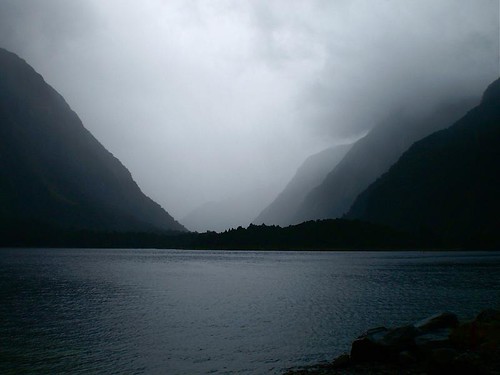
Those of you who chose Samoa or Tonga as my final destination in Marty‘s “Where Will Tony Die?” deadpool are out of luck (for now anyway). But they were good choices and either could have been a winner.
Unfortunately for you (but not, of course, for me), in Samoa the insects don’t carry many diseases. If they did, things could have turned out a whole lot worse as my blood appears to smell like the nectar of the gods. On the first morning in Apia, following an overnight flight that was too short to get quite enough sleep, and after eventually arriving at my lodgings for the week (a feat made rather more difficult by the no-show of the pre-arranged shuttle they were meant to be sending), I tried to grab a few hours kip. Approximately 15 minutes after falling asleep I was awakened by some friendly staff knocking my door and asking if I wanted any breakfast. I shouted a “no thanks” through the door, and went to turn over to go back to sleep, but then realised that I couldn’t feel or move my right leg. I frantically raced through my mental list of insect bites to see which might cause this, but I was too tired and a little too panicked to get very far in that process. I managed to clamber out of bed and walk about the room a bit until gradually the feeling returned. Relieved, and hoping it wasn’t just a temporary recovery, I jumped straight back into bed and slept for another 4 hours. When I woke I had a large red lump on my leg, but could still move. Over the rest of the week that lump was joined by about 300 more, spread all over my arms, legs, hands, face, neck, and feet.
Your other opportunity in Samoa was some sort of suntroke related fatality. There only seemed to be two weather settings: aggressive thunderstorm or oppressive heat that burns every piece of exposed skin within 30 seconds. The sunburn I ended up with in Samoa was so bad that several weeks later, on the flight from Auckland to Dunedin, after a flight attendent threw hot coffee all over me, they thought they’d scalded my arms. But unless it causes skin cancer later in life (in which case you’ll need to check Marty’s small print very carefully), it was non-fatal.
Tonga came much closer, however. Everything went swimmingly until my penultimate day when I finally got around to going on an island tour. One of the stops on said tour was to explore some caves that seemed to be very popular with locals and tourists alike. Each of us was provided with a candle to light our way, apart from a German girl at the very rear who was given the only torch. The candles were almost entirely useless, but luckily I was right behind the tour guide and relied on keeping close enough behind him to match every step he took. This worked fine until we had to stop to wait for the others to catch up (who were also presumably not having much success with the candles and had to measure each step more carefully). Some locals were making their way back and needed to squeeze past us, so the guide asked me to step to the side to give them room. I made the mistake of assuming that he would only ask me to step aside if there was actually somewhere to step to – and promptly fell over the edge. I’m not entirely sure how he managed it, but the guide managed to grab my arm as I vanished and haul me back up onto the path. My candle seemed to take a very long time to hit whatever would have otherwise have broken my fall. Thankfully I manage to end up with little more than a couple of badly scraped fingers, two very large bruises just below each knee, and a noticeable limp for the next few hours.
From what I can tell New Zealand is significantly safer than most other places in this part of the world, so if I were allowed to enter the competition, I’d be picking Australia right now. I hear a significant number of tourists die there each year…
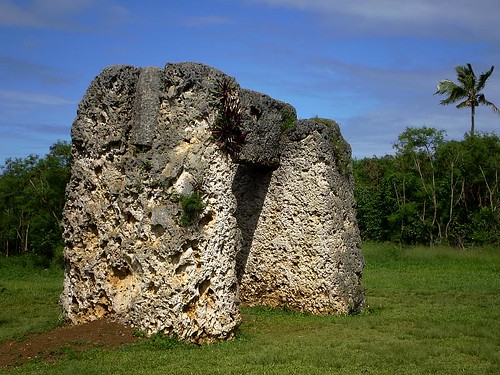
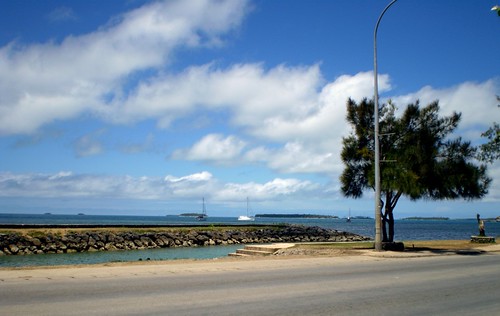
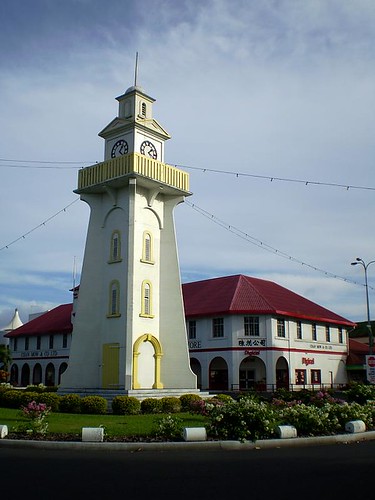
My tour of the Balkans came to an abrupt halt at the start of October. I had planned to spend the next couple of months working my way up the Adriatic coast through Albania, Montenegro and Croatia to Slovenia. However this plan fell apart somewhat when Socialtext appointed a new CEO and summonsed the diaspora to Palo Alto. After some initial confusion as to whether this would apply to the non North-America based people, I had to hastily find a way from Охрид to California. This was much more difficult than I had expected.
Although Охрид is a major tourist destination during the summer (and rightly so), by the end of September most of the flights in and out have stopped. Retracing my steps and flying out from софия again would involve getting the whole way back up Скопје first. The only plausible flight out of Tirana was much too early in the morning to have any sensible way of catching it. Eventually I discovered that British Airways fly from Θεσσαλονίκη to London, and, best of all, depart late afternoon. That just left the problem of getting there. There are no trains or buses across the border between those points. And, as most Macedonian taxi drivers don’t have a visa for Greece, the standard advice is to get a bus to Битола, a taxi from there to the border, cross on foot, get a taxi on the Greek side to the nearest town, and then a bus on to Θεσσαλονίκη.
This would be considerable hassle at the best of times, and has far too much scope for something going wrong when catching a plane. Thankfully one of the hotel staff came to my rescue and arranged for someone he knew with a suitable visa to drive me there for a reasonable price. I started to get a little worried at first, as the drive to Битола took much longer than I had been expecting, but thankfully I had no difficulties at the border crossing this time, and once across the border we made up plenty of time, and I got to airport with almost an hour to spare.
My time in California didn’t go quite as expected. I’d arranged to stay around an extra few weeks to do some on-site customer research, but that ended up falling through (my long rant about this can wait for another day). I did get a lot of useful work done with Liz, though, and got to explore some more of California at the weekends (including stumbling across the rather bizarre Pescadero Apple Festival).
As per my plan to chase the light by flying south for the winter, I’d booked a round-the-world ticket onwards, rather than returning to Europe. As part of the crazy conditions attached to that, I was able to fly into San Francisco, but had to depart from Los Angeles. Thankfully it was a night-time departure, so rather than the hassle of arranging a connecting flight, I decided to drive down the coast instead.
Other than a wrong turn at Oxnard that cost me about 30 minutes heading back in the wrong direction, everything was going smoothly and I would arrive at LAX in plenty of time. Until I joined the 10 at Santa Monica, that is, and found myself in a crazy traffic jam. Apparently two different crashes had caused near-gridlock, so the four miles to the 405 took just over an hour, and then it was another hour for the next five. If the final few miles had been at the same speed I was running a significant risk of missing my flight, but thankfully the jam just suddenly disappeared in the that really strange way that sometimes happens, and I had open roads the whole way to the rental car drop-off.
And thus I find myself in the departure lounge, with several large glasses of Baileys and my last net connection for a while. Next stop Samoa, where I deliberately chose somewhere to stay with no internet service. Detox, here I come.
One of the most common questions I’ve been asked about living in Macedonia was how I coped with everything being written in Cyrillic. Well, actually, more often that not people asked me about things being written in Russian, or complained, when I wrote place names in the local language in email or IM, that they can’t read Russian – which is kind of like noting that in California all the signs are in French.
In Macedonia, of course, it’s even more egregious to call it Russian, as the alphabet actually originated here. I actually didn’t know that prior to this year, but it certainly helps explain why it’s so close to Greek.
Having studied both Mathematics and Theology at university level, I had enough Greek background to find Cyrillic relatively easy to pick up, but anyone who has picked up a smattering of the Greek alphabet is already 50% of the way to being about to transliterate effectively.
 For me the hardest parts are glyphs that look the same in Cyrillic and Latin, but represent different letters. It’s much easier to learn what the unfamiliar characters look like than to train your brain to understand why so many shop windows and advertising hoardings are proudly proclaiming “НОВО!”
For me the hardest parts are glyphs that look the same in Cyrillic and Latin, but represent different letters. It’s much easier to learn what the unfamiliar characters look like than to train your brain to understand why so many shop windows and advertising hoardings are proudly proclaiming “НОВО!”
So here’s the 5 minute guide that’ll get you 90% of the way:
- Р: This is not a P – it’s an R, from the Greek rho. A ‘P’ is actually П (pi).
- С: This is actually an S. It apparently evolved from a Sigma, but it’s much easier to remember that the old СССР isn’t “CCCP”, but “SSSR”, which makes a lot more sense, really.
- В: This is a V. This is fairly common in other languages too, including Hebrew: lots of the names in the Bible aren’t really pronounced the way you were probably taught in Sunday School…
- Н: This is an N. I used to get confused between it and И, which is an I, but now I just remember all those aforementioned НОВО signs.
- У: This is a U. This one is easy for any fans of Тату.
- Ј: This is a Y. Actually it’s not – it’s a J. But it’s a soft J, like in lots of European languages that tend to confuse English speakers anyway, so it’s easier to think of it as a Y.
- Х: Again, thinking in Greek makes this easier. It’s a Chi. In practice it’s a little complicated as sometimes it’s a ‘CH’ and sometimes just an ‘H’. But it’s usually obvious from context, and even if you’re not sure you’ll be a lot closer than treating it as an X.
All the other characters that look like English (АKЕMOT) are all what you’d expect, so once you stop falsely transliterating the lookalikes, you’re well on your way.
- Ф is like the greek Phi, and is usually just transliterated as ‘F’, although sometimes ‘PH’ might work slightly better.
- Г is a G, but tricks people who only know Gamma as γ and aren’t familiar with its capital form.
- Д, thanks to Borat, now confuses people. To me it’s always been obviously a D, just written a little differently. For my part I got confused when I first saw a movie poster for “300“, as I was living in Estonia at the time and assumed the poster was in Russian, where З is a Z (not to be mistaken for Э which is a short E, but they don’t have that character in Macedonian so it’s not so confusing here).
- Л, according to my keyboard and most websites, is an L. But it’s hardly ever written like that (in Macedonia, anyway) usually it’s more like an upside-down V. Unicode doesn’t have such a symbol in the standard Cyrillic range, so I’m not sure what sign-makers use in its place (the closest I can find is U+2227: ∧, but it’s not quite right). A garage near my apartment is still proudly displaying an old ∧А∆А sign (which looks much more effective with proper typography).
Occasionally you’ll come across a few other strange characters that you’ll have to learn later, but this subset will get you remarkably far.
Curiously, Macedonian doesn’t include one of the iconic characters regularly used in faux-Russian: Я (ya). This is a very common letter in Russian as it’s also the word for the first person pronoun (“I”), but doesn’t exist in Macedonian at all. This is why the capital city is spelled Скопје whereas the neighbouring capital, which is pronounced very similarly, is written София.
Within a few weeks of moving to Скопје I was able to transliterate most street signs etc fairly quickly, which helped in finding my way around. And even without being able to translate, lots of words are rather obvious once you’ve converted the letters. This sometimes goes awry though: the first time I took a slug from a carton of Млеко to discover that even though it looked like a milk carton, and ‘mleko’ sounds close enough to ‘milk’, I was actually drinking yoghurt.
 And I still can’t see the T-Mobile ‘е-Ваучери’ signs without thinking that there’s some sort of hook-up with eBay…
And I still can’t see the T-Mobile ‘е-Ваучери’ signs without thinking that there’s some sort of hook-up with eBay…
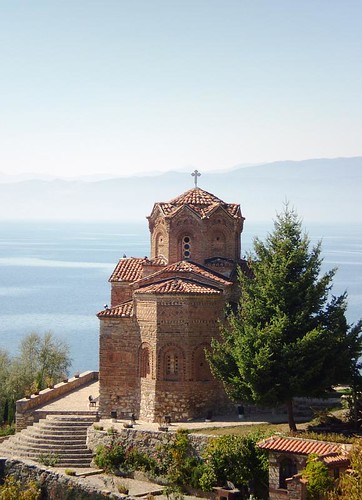
Having entered Greece in rather strange circumstances, I was a little concerned as to what might happen should I travel back to Скопје through the same border point, just in case the frustrated waving me on was under some sort of “Well, he’s only a stupid tourist and he’s unlikely to be back any time soon” belief. So I decided to travel up to софия for a few days, and then go back across that way. Eager readers may remember that that’s how I entered Macedonia in the first place, but that time I only got to spend a few hours being driven around the back roads of софия, rather than actually getting to experience the city.
As Greece and Bulgaria are both in the EU these days, I expected the border crossing to be a relatively simple affair. In this I was completely mistaken. The train sat for well over an hour and half at the border. As best I could ascertain there were only about 10 passengers, so I’ve no idea what was going on, especially as I was tucked away in a compartment in the first class cabin with no other passengers. I didn’t actually buy a first class ticket, but somehow the train station in Thessaloniki managed to allocated me a reserved seat in the first class cabin on a second class ticket. Both of the ticket inspectors who examined it during the journey did a visible double take at this, but as I was sitting in the correct car/seat combination there wasn’t a lot they could say.
I’d pre-booked an apartment for a few days in the centre of софия, and there was meant to be a driver waiting for me at the station on arrival, but the delay at the border meant that by time I got in it was after midnight, and the driver was nowhere to be found. I rang the woman I’d booked it through (although I’m pretty sure I woke her up), and after she’d ascertained that the driver had gone home for the night, she offered to pick me up herself. She explained she was nearby, and so would meet me outside the McDonalds at the station in 10 minutes.
This sounded much simpler than it actually turned out to be. I walked the whole way around the outside of the station, and couldn’t see a McDonalds at all. The one remaining taxi driver claimed not to know where it was (although if I were feeling particularly suspicious I’d think he was trying to sabotage my lift so that his hanging around waiting for the last train wouldn’t have been a complete waste of time, particularly as his price also dropped by €5 at this point…)
With a time restriction in place, I couldn’t just keep wandering around on my own hoping to find it, so I tried to find somewhere else who could tell me where it was. Of course, after midnight that’s not a trivial thing to do either. There had been some workers down where I’d gotten off the train, so I tried to retrace my steps back in that direction, but got hopelessly lost by virtue of all but one of the entrances to the station being locked for the night. Eventually I found the right combination of steps to descend, back into the bowels of the underground part of the station, and the right steps to ascend again, back to the track where the train was. However, by now there was no-one to be found. So I went back down into the station and wandered around hoping to find someone. Eventually I found some cleaners, but they spoke no English. I hoped that simply looking lost and asking “McDonalds?” should suffice for them to be able to at least point in the right direction but the looked completely confused. Over the next 5 minutes, growing increasingly worried that my lift would disappear again, I repeated the charade with a variety of night workers, all with the same result (or lack thereof).
At this point, as I passed the bottom of a stairway that led up to one of the tracks, my mobile phone managed to get a signal, and helpfully informed me that I’d missed 4 calls. Checking my messages I discovered that the woman picking me up had arrived at the station to discover that it was all locked and so couldn’t even get to the McDonalds, even had I been able to find it, and she was waiting for me outside by the front entrance. My next adventure was trying to find my way back to there. In my quest for anyone who spoke enough English to understand the work “McDonalds” I’d gotten completely lost underground. Eventually, after about a further 15 minutes of increasingly panicked wanderings, I found my way to the front entrance: but, unfortunately, the wrong side of it, where the heavy duty chains made it clear I wasn’t going to get out that way any time soon. The woman picking me up, on the other side of the door, looked remarkably exasperated and she berated me for not knowing that her suggestion to meet at McDonalds made no sense if the station was locked and just waited for her outside instead! She had no suggestions for how I could manage to find out which sets of stairs and doors would lead me back across, down, round, up, and around again to her side. So I set off on further exploration on the understanding that if I hadn’t found my way out in 10 minutes she was calling the police to come get me out.
Thankfully I made the right guess fairly quickly, reached somewhere that looked familiar, and made it out in just over 5 minutes this time. As we walked over to her car, the lone taxi driver, visibly deflated, clambered into his, and drove off. And I still had no idea where McDonalds was.






